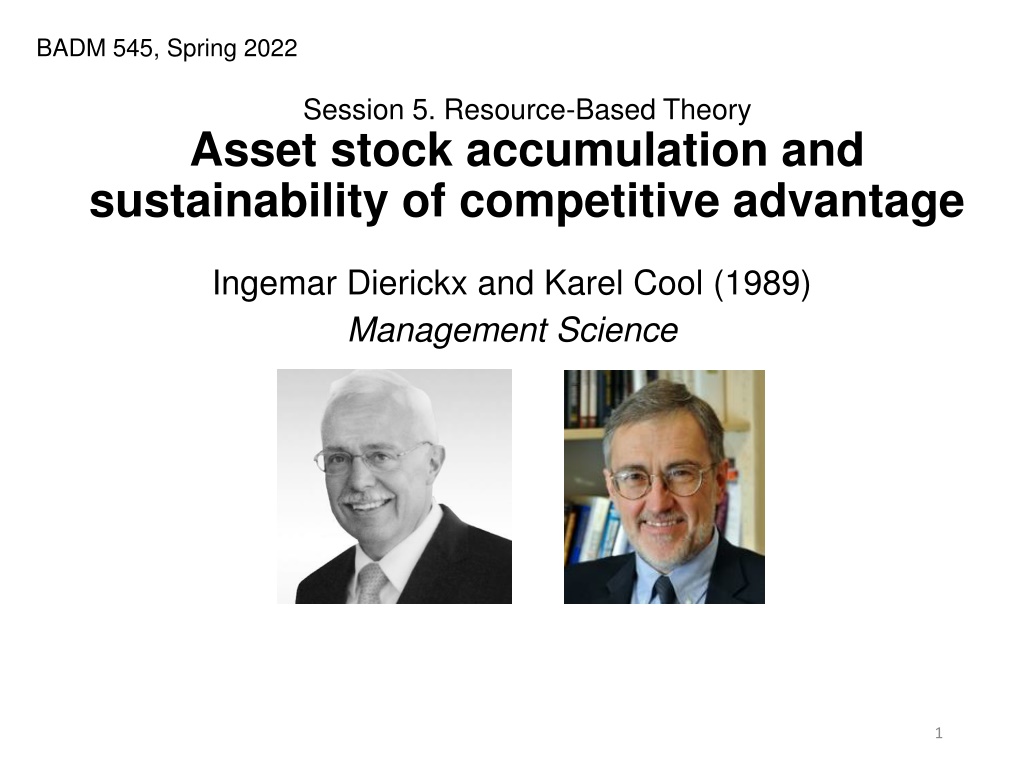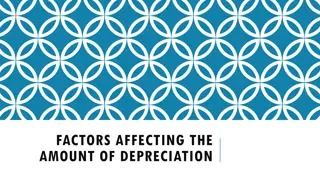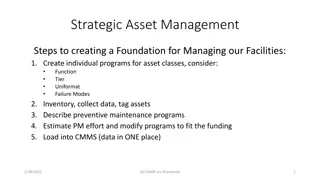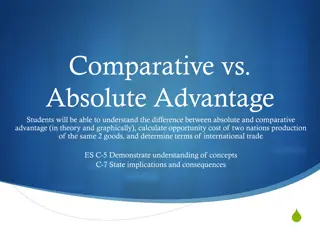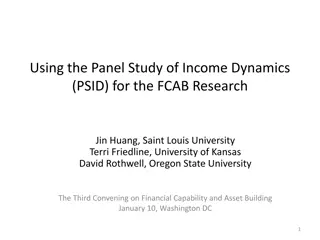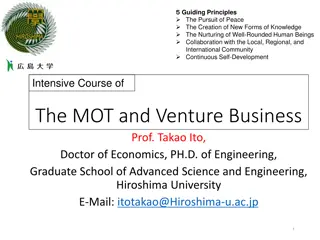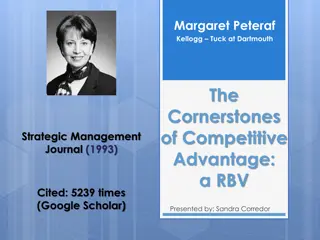The Importance of Asset Stock Accumulation for Sustainable Competitive Advantage
Strategy literature often overlooks the crucial role of building and accumulating non-tradeable asset stocks for achieving and safeguarding competitive advantage. The concept of asset stock accumulation provides a complementary framework to evaluate the sustainability of a firm's competitive edge, emphasizing the strategic significance of internally accumulating valuable resources over time. This approach challenges the conventional focus on product market positions and highlights the necessity of protecting firm-specific assets from imitation and substitution. The metaphor of a bathtub illustrates the strategic process of managing flows (inputs) to build critical asset stocks (outputs) that are non-tradeable, non-imitable, and non-substitutable.
Download Presentation

Please find below an Image/Link to download the presentation.
The content on the website is provided AS IS for your information and personal use only. It may not be sold, licensed, or shared on other websites without obtaining consent from the author. Download presentation by click this link. If you encounter any issues during the download, it is possible that the publisher has removed the file from their server.
E N D
Presentation Transcript
BADM 545, Spring 2022 Session 5. Resource-Based Theory Asset stock accumulation and sustainability of competitive advantage Ingemar Dierickx and Karel Cool (1989) Management Science 1
Introduction Strategy literature has focused too narrowly on privileged product market positions as a basis for competitive advantage. Resource bundles need to be deployed to achieve or protect product market position is often overlooked. o Analytical problem: the opportunity cost of scarce assets o Managerial problem: managers need to realize that bundle of assets leads to their firm s success needs to be protected from imitation and substitution. Barney (1986): strategic factor markets imperfectly competitive : Firms may have different expectations about the future value of a strategic asset. Antecedents: superior information, luck, or both. Purposes: (1) Discuss limitations of strategic factor market concept (2) Provide complementary framework based on notion of asset stock accumulation (3) Develop guidelines for assessing the sustainability of a firm s competitive advantage 2
Incomplete vs. Imperfect Factor Markets Barney (1986): imperfect markets. Useful to evaluate the opportunity cost of deploying assets Implicit assumption: All required assets to implement a given strategy that are traded can be bought and sold. (e.g., reputation) Whether strategic factor markets are complete? To what extent can factors which are freely traded in open markets be termed "strategic"? Non-tradability of assets sustainable competitive advantages Non-appropriability of assets: various sources including absence of well-defined property rights or bookkeeping feasibility problem Firm-specific assets: the imperfect substitute is acquired in the market, but the firm-specific component is accumulated internally - - A complementary framework is required to gauge the sustainability of stream of quasi rents generated through the deployment of non- tradeable assets 3
Accumulation of non-tradeable asset stocks When neither the desired strategic input factor itself nor any close substitute for it can be acquired through a market, firms are constrained to "building" it. Strategic asset is the cumulative result of adhering to a set of consistent policies over a period of time ( flows ). R&D bathtub Stock of know how: current amount of water in the tub Flow: current R&D spending Flows can be adjusted instantaneously, but stocks cannot! Key task: appropriate time paths of relevant flow variables must be chosen to build required stocks of critical assets. Strategic asset stocks are non-tradeable, non-imitable, and non- substitutable 4
The Bathtub Metaphor Exhibit 4.7 SOURCE: Figure based on metaphor used in I. Dierickx and K. Cool (1989), Asset stock accumulation and sustainability of competitive advantage, Management Science 35: 1504 1513. Access the text alternative for slide images.
Sustainability of privileged asset position Sustainability of a firm s privileged asset position hinges on how easily it can be replicated (imitation, substitution) The imitation of asset stocks - Time compression diseconomies: the law of diminishing returns when one input, viz time, is held constant early mover advantage (e.g.: R&D know how) - Asset mass efficiencies: adding increments to an existing asset stock is facilitated by possessing high levels of that stock - Interconnectedness of asset stocks: accumulating increments in an existing stock may depend on the level of other stocks - Asset erosion: all asset stocks decay in the absence of maintenance expenditure fast decaying stock is hard to establish a credible threat to entry - Causal ambiguity: it is impossible to fully specify which factors play a role in asset stocks accumulation process The substitution of asset stocks Threat that successful substitution renders original asset stocks obsolete they no longer create value to the buyer 6
Conclusion and Discussion Conclusion - Asset stocks are strategic to the extent that they are non-tradeable, non-imitable, and non-substitutable - A firm s current strategy involves choosing optimal time paths of flows, whereas its competitive position and profitability is determined by the level of its stocks Contributions - While Barney (1986) address market imperfection , this paper provides a complementary framework for the sustainability of quasi rents through deployment of non-tradeable assets This paper provides a time-based view of competitive strategy (time compression diseconomies) provides - - 7
